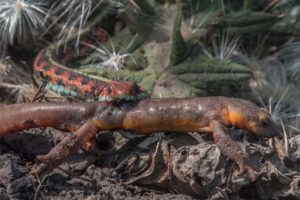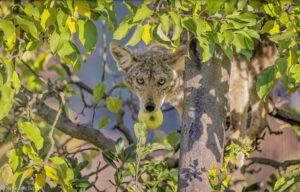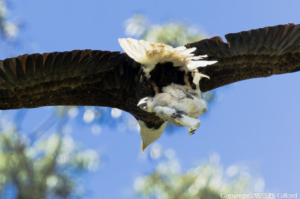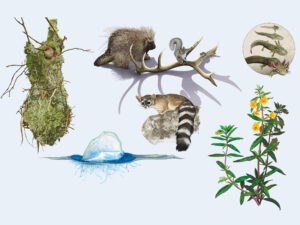Dropping into San Francisco International Airport at dusk, a passenger in the window seat looks out at threads of sunlit clouds, a frill of ocean, dark beach, lights blinking on in parking lots and ball fields. The city itself is just a thin band between the Pacific and San Francisco Bay. The plane soars past the San Mateo–Hayward Bridge, over a trail of islands, losing elevation. It seems like it will land in the kicking waves, until at the very last moment, the ground rises up and the plane touches down, with a bump and a roar, on a paved runway banked by yellow turf.
For a migrating red-tailed hawk, the airport from above holds charms beyond the panorama: promise of a vole scurrying in the grass, a light-pole perch, ample water, scant people.
“Airports in general have to be built on wide-open flat spaces,” says Natalie Reeder, SFO’s in-house biologist. “If you literally take a bird’s-eye view and look at the satellite image of the area, we have the best grassland around. I can imagine being a barn owl, being a red-tailed hawk, flying around seeing this great big lawn and coming straight here.”
This airport, and others, draws animals of all sorts. Airports are often the last remaining spots of undeveloped land in cityscapes bristling with freeways and office complexes. Sure, these territories are inhabited by giant machines, but they also tend to be banked by bays, rivers, and oceans, offering plenty of food. Coyotes, peregrine falcons, great blue herons, and gray foxes find their way. This creates both potential and problems. On the one hand, the roughly 2,000 dry-land acres of SFO host thriving populations of threatened and endangered species. On the other, bird-airplane collisions cause deadly accidents and hundreds of millions of dollars in damage across the United States each year. It’s a high-stakes kind of coexistence. Reeder’s job—and that of other airport biologists like her—is to balance these competing concerns, keeping wildlife safe from humans and humans safe from wildlife. And how best to do this is a question with no easy answer.

This spring afternoon, Reeder’s initial focus is conservation. She unlocks a chain-link fence and enters a sliver of airport property that seems unlikely habitat. On one side, a BART train squeals as it slows. On the other, airplanes rocket into the sky. Traffic humming along the 101 overpass zooms past signs: “Hotel,” “Rental Car Return,” “Long-term Parking.” Invasive blackberry and ice plant run riot.
But as Reeder walks toward a tiny pond, a different ecosystem comes into focus. This undeveloped 180-acre plot contains some of the best remaining habitat for the San Francisco garter snake, a subspecies that appears on state and federal endangered-species lists, as well as its favorite prey, the threatened California red-legged frog. The snake likes shallow wetlands for hunting and uplands for basking, available here. At Reeder’s approach, the pond water ripples as hundreds of Pacific chorus frog tadpoles scatter. Orange plastic ties on plants mark softball-size clusters of California red-legged frog eggs.
“We kind of farm frogs to feed snakes,” Reeder says, scooping up a chorus frog tadpole, a gelatinous marble with a lashing black tail, with her hand. As a result, part of her job is to make the area frog-friendly. This involves yanking vegetation in the canals to create the open water the frogs need to lay eggs and hide from predators. She and her team also cut back invasive plants and spay and neuter feral cats that roam the weeds. It’s a lot of work, but the effort appears to be appreciated. “Every time we clear a section of cattails it seems like the next year the frogs come there and lay their eggs,” she says.
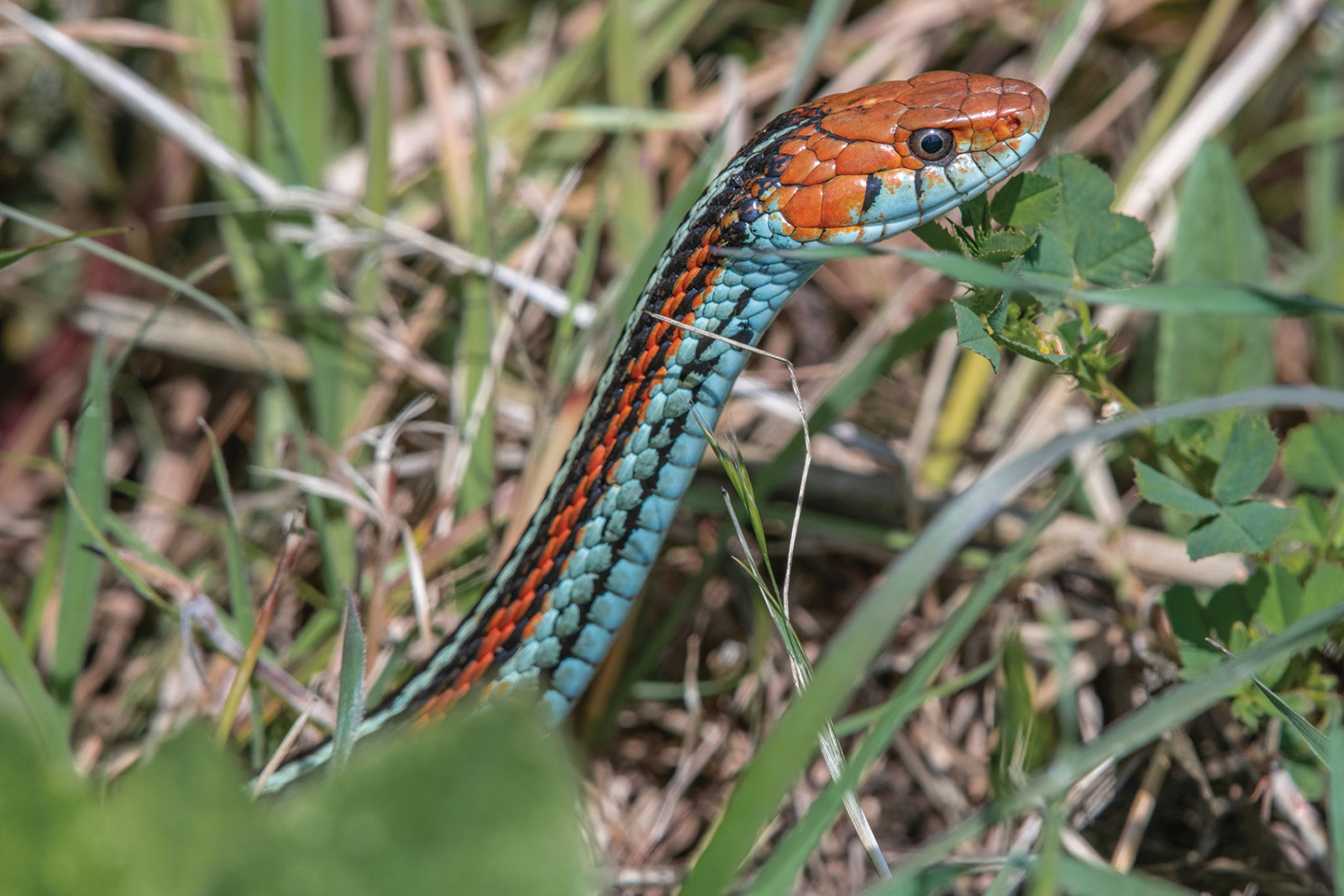
She surveys red-legged frogs, eggs, and tadpoles each year and snakes every five years. And the snakes at SFO, endemic to the San Francisco Peninsula and northern Santa Cruz County, are flourishing. While trapping efforts at the site in the mid-1990s yielded only 25, the 2017 tally estimates a healthy 1,317. This represents a big chunk of the total San Francisco garter snake population, which may be less than 2,000. The next count is scheduled for this summer.
The fact that this land, called “West-of-Bayshore,” remains undeveloped though ringed by homes, iPhone billboards, and luxury hotels is a quirk of history. Along with the grizzly bear, the American alligator, the black-footed ferret, and the ivory-billed woodpecker, the San Francisco garter snake slithered its way onto the very first version of the Endangered Species List, created under the Endangered Species Preservation Act of 1966. Snakes don’t usually get this kind of attention, but this one glitters like a necklace with stripes of scarlet, black, and electric blue. The Golden Gate National Parks Conservancy website enthuses, “It is just a wonderful serpent.”
And that federal protection shaped the bayfront. Plans for a stadium at the site were shelved. Condos never materialized. When BART launched a long-awaited expansion to the airport, a project that crossed the property, snakes were captured and housed in sunny terraria to wait out the building. And when, in spring 2000, a dead snake turned up at the site, crushed by heavy equipment, construction stopped for 18 days while BART officials tried to figure out a solution. Eventually work proceeded, but at a slower pace. The company installed a 5-miles-per-hour speed limit. Biological monitors watched over the project. Construction workers mastered snake ID.
Protection for the snake acts like an umbrella, shielding other animals, too. Snake traps have caught long-tailed weasels. Coyote scat dots the gravel. Anna’s hummingbirds zoom by the concrete supports of the overpass. Buffleheads bob in the cattails.
“When I started out working in biology, I imagined myself working in a national park, something a little more pristine, but one of the things I love about this place is it’s pretty incredible and inspiring how much can live here,” Reeder says. She gestures east to the international terminal and west to the train tracks and downtown Millbrae. “Just having this relatively small green space…all of these animals are able to use it.”
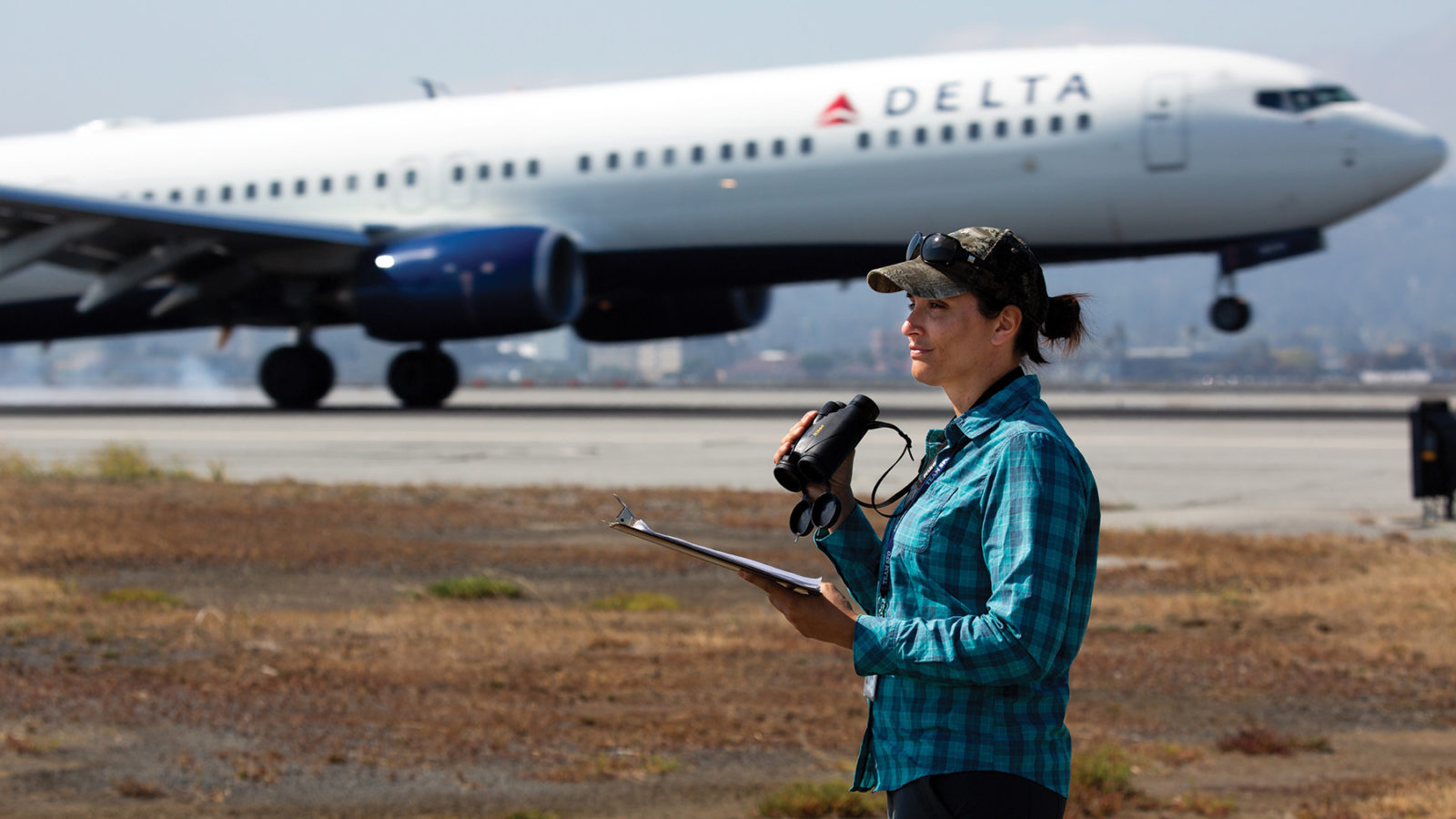
Reeder is enthusiastic about this side of her job, cultivating these rare critters or dealing with the odd calls that come her way: a yellow-bellied marmot (a species most often found high in the mountains) running along the frontage road, a vulture foot sticking out of a wing of a plane filled with dignitaries from Japan, a sea lion hauling out into the airfield. (Luckily, there is a wildlife rehab center nearby.)
But encouraging wildlife at airports is a tricky business, because some species, particularly flocks of large-bodied birds, are potentially deadly hazards. So the second prong of the work of an airport biologist is keeping animals away from planes at all costs. A bird strike was the cause of the 2009 emergency river landing of US Airways Flight 1549 that inspired a movie about the “miracle on the Hudson” starring Tom Hanks. A flock of Canada geese, sucked into both engines, brought down the plane.
The high-profile crash inspired many airports to take these hazards even more seriously than they had before. For a long time, the approach to dealing with troublesome animals was to kill them, and thousands of birds that linger near airspace are still shot at airports, including those in the Bay Area, each year.
But airports also experiment with nonlethal methods. They explode fireworks, shoot loud air cannons, wave green lasers, install fences, keep the mixture of nonnative grasses and forbs mown to discourage birds, install fake coyotes to frighten pigeons. Sometimes these tactics work, scaring animals away. And sometimes red-tailed hawks perch on the cannons, coyotes scale the fences, using the barbed wire for leverage, and birds defecate on the plastic predators.
Airports also try to catch problems before they develop. To this end, Reeder walks deeper into West-of-Bayshore and begins a bird survey. Steadying binoculars in the buffeting wind, she counts song sparrows and coots and points out the heads of two Canada geese poking above the lupine. If a big flock gathers, it might cause concern. This data means “we can really figure out which species we need to be focused on and then also perhaps—this is kind of a big perhaps—we might be able to evaluate our actions and see whether they’re working.” These kinds of studies have shown that, for example, birds most often hit aren’t the thousands of ducks clustered by the airfield in winter, but barn owls blinded in their pursuit of grassland prey.
Learning what works—to scare a goose away, to attract a red-legged frog—requires a scientific approach, and that is what Reeder is aiming for at SFO. “Each species is its own unique system. And has different habits and different needs and different food,” she says. “There’s a lot of work being done at airports around the country, around the world, understanding these more minute details about how we can better manage wildlife in a way that’s more effective than just going in and killing everything.”
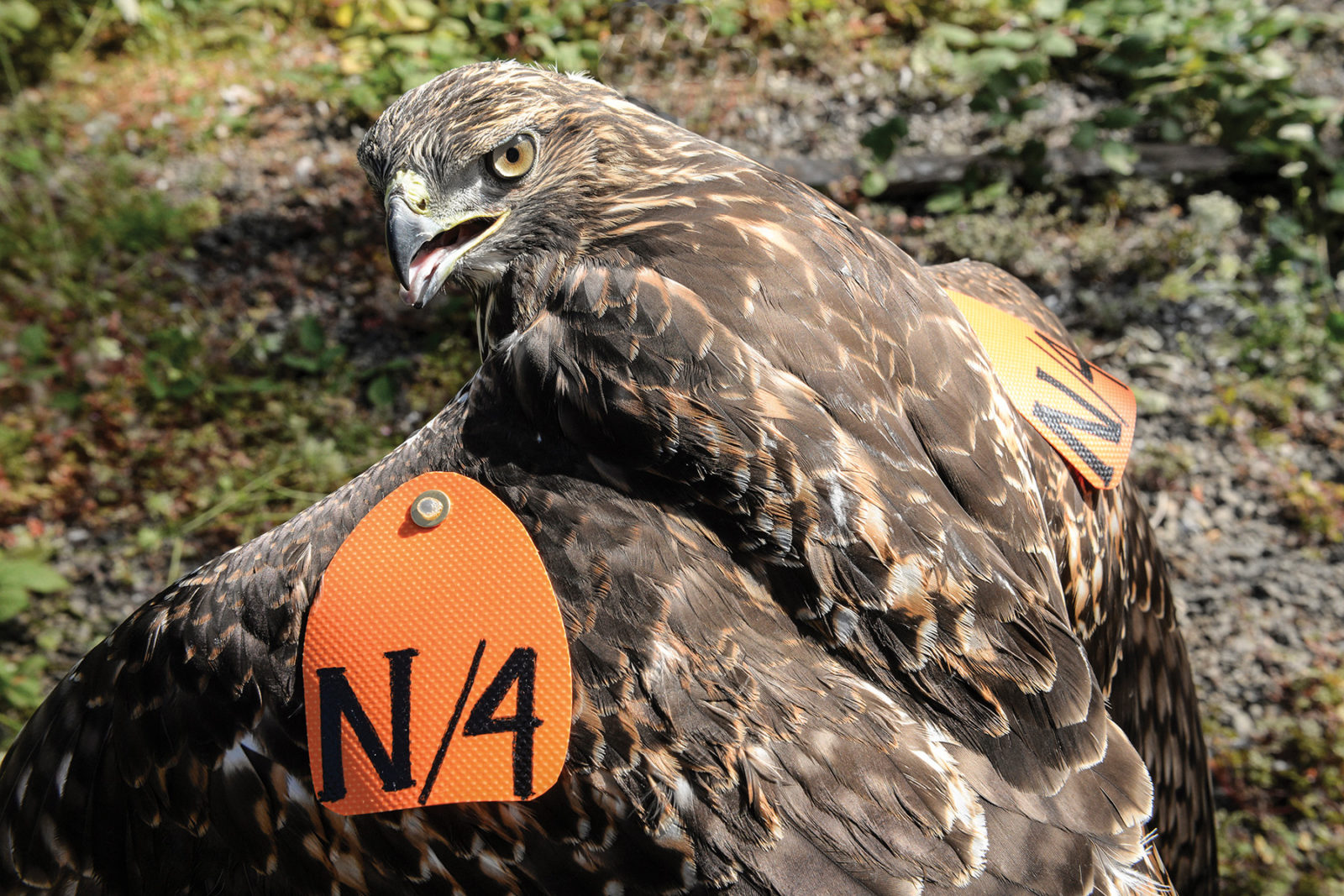
U.S. airports are divided between those that have in-house biologists and those—like Oakland International Airport and Norman Y. Mineta San José International Airport—that contract with USDA’s Wildlife Services, a division focused on controlling “nuisance” species. (USDA biologists working at these airports declined to be interviewed for this story.)
While the program at SFO is young—Reeder, hired seven years ago, is the only one on staff—other airports have had in-house biologists for decades. Seattle’s international airport, Sea-Tac, was the first U.S. airport to hire a full-time wildlife biologist, in 1976. Portland’s airport, PDX, located at the tempting confluence of two rivers and on the Pacific Flyway, has a staff of 11. Since 1999, they’ve been honing their approach, including trapping, tagging, and relocating raptors—as many as 3,500 in total—that veer too close to the planes. Sometimes the birds return—they can fly across continents, after all—but the relocations aim to prevent this, at least in the short term. If red-tailed hawks are migrating south, managers move them farther south, a little boost on the way. SFO has just started to trap and release both hawks and barn owls.
These strategies can be time- and resource-intensive. Both USDA contract biologists and in-house biologists make the airport safer, according to Nick Atwell, a senior Natural Resources and Wildlife Manager for the Port of Portland and the chairperson of Bird Strike Committee USA. But an in-house biologist might have more knowledge of a specific facility’s ecosystem, down to individual birds, compared to a contractor who may be responsible for multiple airports. For example, six pairs of red-tailed hawks nest at PDX and managers let them. The resident raptors are airport savvy, the reasoning goes. They’ve proven that they can stay out of the way of planes and chase away more naive birds. “Having that continuity from my perspective is the ideal way to go,” Atwell says.

If San Francisco garter snakes are welcome at SFO and Canada geese are unwelcome at airports everywhere, the western burrowing owl occupies a territory somewhere in between.
At 10 inches high and with long legs that come out of nowhere, like those on a high school cross-country runner, it pushes our understanding of “owl.” Particularly when it starts tossing dirt from the mouth of its underground burrow (often stolen from a ground squirrel), where it shelters and nests.
Burrowing owls are unique in other ways, too. While the famous bowerbirds of New Guinea might decorate their nest with colorful shells and flowers, the owls bedeck their burrow entrances with goose poop, soy sauce packets, and cigarette butts. They have a high tolerance for disturbed habitat. And they really like airports. The wide swaths of low grass, riddled with ground squirrel burrows, and lack of trees for owl predators like hawks to perch in—all these draw them in. In the 1960s, when Lise Thomsen, with the UC Berkeley Museum of Vertebrate Zoology, conducted an early study of burrowing owl behavior, she chose to look at the population at the Oakland airport, one of the largest in the Bay Area. One year she tracked about 60, including 18 breeding adults hatching out 31 young.
In the face of conversion of grasslands to development and agriculture, western burrowing owl breeding populations, particularly in the San Francisco Bay Area, have been on the decline. After an unsuccessful battle to get the owl on the state threatened and endangered species list in 2003, the owl remained only a “species of special concern,” a designation that came with fewer protections than those that halted BART construction for the sake of the snake.
In San José, burrowing owls lived for decades on airport grounds, sometimes very near where planes would pass. Between 1990 and 2009, managers installed 113 artificial burrows at the San José airport to lure nesting owls from the most dangerous part of the airport—the center of the runway and the ends where planes take off and land—to the sides. Irrigation valve boxes (plastic tubs) were sunk into the ground with a 10-inch-diameter plastic tube connecting them to the surface. Sometimes, the nest boxes were installed Friday and by Monday the owls had moved in.
The owls apparently didn’t mind the noise, the huge metal bird blotting out the sun. “It was amazing to see the wings of an airplane basically going over a burrow that was occupied by burrowing owls, and it did not faze them. They were used to it. They knew it was not a threat,” says Sandra Menzel, who monitored burrowing owls for a consulting firm, Albion Environmental, and conducted a study about the effectiveness of the artificial burrows at the San José airport. “It was, I think, really predictable for them and so they managed very well.” The San José airport population is now one of four remaining such populations in Santa Clara County.
Menzel found that maintenance—removing plants from the top of the burrows annually and cleaning out the whole structure every five years—kept the burrows attractive as nesting sites for the owls. In 2002, 40 breeding pairs lived at the San José airport.
But the airport tried to coax the birds farther from the runway to a plot of land across the road—relocating 99 artificial burrows between 2012 and 2014. The owls didn’t get the memo. And the burrows were neglected. A 2019 Biological Resources report accompanying an amendment to the San José airport master plan describes tall grass, lack of burrows, and perches for burrowing owl predators at the new location. It concludes that the new site “does not currently provide suitable nesting or roosting habitat for burrowing owls.”
The population dropped to five nesting pairs in 2018. According to a 2022 email from the airport’s public information manager, “the artificial burrows were not maintained and are buried.” Recent surveys found only one owl.
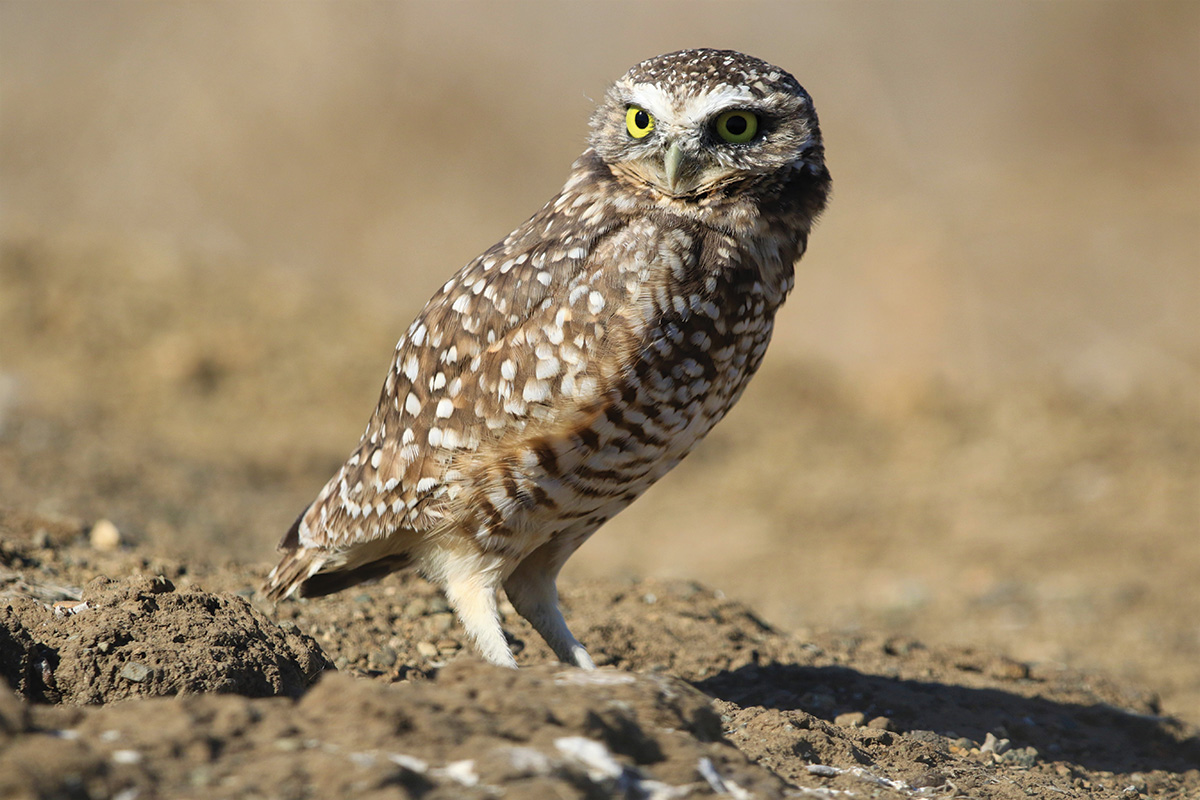
Airports have always offered a vision of the future, knitting the world together with technological advances. But accurate predictions can be hard to make. One can only plan and hope. When preserving habitat, in particular, it’s impossible to know exactly what or whom you are saving it for.
The West-of-Bayshore property promotes breeding of snakes and frogs, as intended, but in the intervening 50 years the landscape around it has transformed. At the time of the San Francisco garter snake listing, there was no BART. The airport was just entering the jet age. Now, the plot offers benefits previously unimagined. Wetlands filter pollutants from dense new developments. Ponds absorb water as winter rains become more severe as a result of climate change, relieving pressure on the stormwater system.
Another surprising change is the return of species given up for dead. Many animals protected at the same time as the garter snake—the bald eagle, the brown pelican, the peregrine falcon—had been poisoned to near extinction by DDT. They have soared back since it was banned in 1972. During those same years, a time of artificial scarcity of the large birds, airports expanded, adding runways, spreading their reach. So sprawling airports and healthy bird populations are only now coexisting.
SFO is seeing the impact of these shifts. The first bald eagle turned up on the airfield recently, and flocks of brown pelicans float by with increasing frequency. A pair of peregrine falcons nests in the United Airlines hangar. It’s good news but adds urgency to these management questions.
Reeder ends the afternoon with another bird survey—American wigeon, northern shoveler, canvasback—this time at blustery Bayfront Park. As ducks flicker over the waves and plane after plane lands on a runway that appears to reach impossibly far out into the water, she comments that meeting this uncertain future will require increased creativity—maybe engineering engine resilience to bird strikes or developing bird-scaring technology to go right on the planes. There’s a lot of possibility, she notes, so many approaches that are “much more sophisticated, effective, and environmentally friendly than just shooting birds.”


